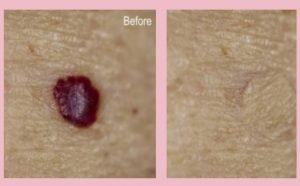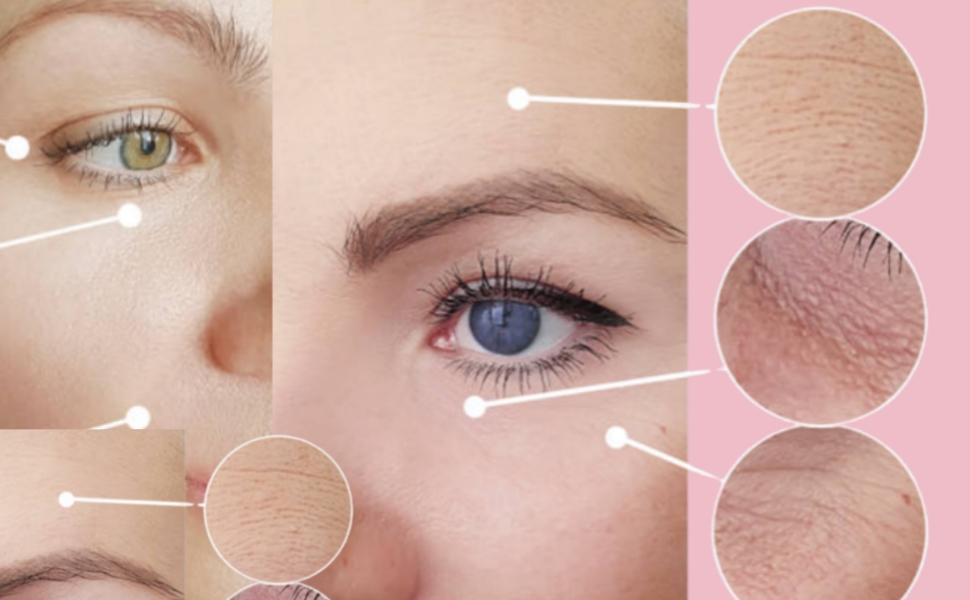If you’ve ever wondered about the effectiveness of laser skin tag removal, then this article is for you. Laser skin tag removal is a popular and non-invasive treatment option that can help you get rid of those pesky and unsightly skin tags. In this article, we will explore the process of laser skin tag removal and discuss its benefits, safety, and effectiveness. So, if you’re ready to bid farewell to those bothersome skin tags, keep reading to learn more about this innovative treatment option.
Definition and Description of Skin Tag
Skin tags are small, benign growths that typically appear on the skin’s surface. They are usually painless and soft to the touch, and often resemble small flaps of skin. Skin tags can vary in size and color, but they are generally the same color as the surrounding skin. They are commonly found on areas of the body where the skin folds or rubs against itself, such as the neck, armpits, eyelids, and groin.

Causes and Risk Factors
The exact cause of skin tags is still unknown, but certain factors can increase the likelihood of developing them. Skin tags are more commonly seen in individuals who are overweight or obese, as the excess skin folds can create the perfect environment for their growth. Hormonal fluctuations, such as those experienced during pregnancy, can also contribute to the formation of skin tags. Additionally, age and genetics may play a role in their development.
Common Locations
Skin tags can appear on any part of the body, but there are a few areas where they are more commonly found. The neck is a common location for skin tags, as the skin tends to fold and crease in this area. Armpits are another common location, as the constant friction from movement can lead to their formation. Skin tags can also develop on the eyelids, groin area, and underneath the breasts. It’s important to note that skin tags are harmless and do not require medical treatment unless they cause discomfort or cosmetic concerns.
Traditional Methods for Skin Tag Removal
Laser Skin Tag Removal: Home Remedies
There are several home remedies that people may try to remove skin tags, although their effectiveness is not scientifically proven. Some home remedies for skin tag removal include tying off the skin tag with dental floss, applying apple cider vinegar, or using over-the-counter creams or solutions. It’s important to exercise caution when attempting to remove skin tags at home, as improper techniques can lead to infection or scarring. If you are considering home remedies, it’s best to consult with a healthcare professional first.
Over-the-Counter (OTC) Products
Over-the-counter products specifically designed for skin tag removal are available at most pharmacies. These products often contain ingredients like salicylic acid or tea tree oil, which are believed to help remove skin tags. It’s important to follow the instructions on the product carefully and discontinue use if any adverse reactions occur. While OTC products may work for some individuals, they are not guaranteed to be effective in all cases.
Medical Procedures
For those who want to remove skin tags quickly and effectively, medical procedures are a popular option. Dermatologists and other healthcare professionals can perform procedures like cryotherapy, where the skin tag is frozen off using liquid nitrogen, or cauterization, where the skin tag is burnt off using a special tool. These procedures are typically quick and relatively painless, and they offer immediate results. However, it’s important to note that medical procedures can be more expensive than home remedies or OTC products.
Introduction to Laser Skin Tag Removal
Laser skin tag removal is a modern and non-invasive procedure that uses laser technology to remove skin tags. It is a safe and effective method that targets the skin tag without damaging the surrounding skin. Laser skin tag removal is performed by a trained professional, typically a dermatologist or cosmetic surgeon, who uses a laser device to precisely cut off the blood supply to the skin tag, causing it to shrink and eventually fall off.
How Does It Work?
During laser skin tag removal, a high-intensity laser beam is focused on the skin tag. The laser energy heats up and destroys the tissue, effectively removing the skin tag. The laser is precise and can target the specific area without causing damage to the surrounding skin. The procedure is usually performed under local anesthesia to ensure the patient’s comfort.
Benefits of Laser Skin Tag Removal
Laser skin tag removal offers several benefits compared to traditional methods. Firstly, it is a non-invasive procedure, meaning there are no incisions or stitches involved. This reduces the risk of scarring and infection. Additionally, laser removal is quick and efficient, with minimal downtime. Patients can resume their daily activities immediately after the procedure. Finally, laser skin tag removal is known for its high success rate, with most patients seeing permanent removal of their skin tags.
Preparing for Laser Skin Removal
Consultation with a Professional
Before undergoing laser skin tag removal, it’s important to schedule a consultation with a qualified professional. During this consultation, the professional will evaluate your skin and discuss your goals and expectations for the procedure. They will also review your medical history to ensure you are a suitable candidate for the treatment.
Skin Examination and Evaluation
During the consultation, the professional will carefully examine your skin and evaluate the skin tags you wish to remove. They will determine the quantity, location, and characteristics of the skin tags to develop an appropriate treatment plan. This evaluation is crucial in determining the success of the laser skin tag removal procedure.
Skin Preparation
In preparation for laser skin tag removal, the professional may advise you to refrain from using certain skincare products or medications that could interfere with the procedure. It’s important to follow these instructions carefully to ensure the best possible results. Additionally, proper skincare routines, such as keeping the area clean and moisturized, may be recommended to aid in the healing process.
Skin Tag Removal Procedure
Administering Anesthesia
Before the laser skin tag removal procedure begins, the professional will administer a local anesthetic to the treatment area to ensure the patient’s comfort. The anesthesia will numb the area, minimizing any potential discomfort during the procedure.
Laser Application on Skin Tags
Once the anesthesia has taken effect, the professional will begin the laser skin tag removal procedure. They will carefully apply the laser to the skin tags, targeting them with precision. The laser will destroy the tissue of the skin tags, cutting off their blood supply and causing them to wither and fall off over time.
Post-Treatment Care
After the laser skin tag removal procedure, the professional will provide instructions on how to care for the treated area. This may include keeping the area clean, avoiding excessive sun exposure, and applying any recommended topical ointments or creams. It’s important to follow these instructions closely to ensure proper healing and reduce the risk of complications.
Recovery and Aftercare
Expected Recovery Time
The recovery time for laser skin tag removal is typically minimal. Most patients can expect the treated area to heal within a week or two. However, individual healing times may vary depending on the size and location of the skin tags. During the healing process, it’s normal for the treated area to be slightly red or swollen, but these symptoms should disappear within a few days.
Possible Side Effects
While laser skin tag removal is generally safe, there are some potential side effects to be aware of. These can include temporary redness, swelling, or mild discomfort in the treated area. In rare cases, blistering or scarring may occur. It’s important to discuss any concerns or potential side effects with the professional performing the procedure.
Aftercare Instructions
Following laser skin tag removal, it’s important to follow the aftercare instructions provided by the professional. This may include keeping the area clean and dry, avoiding excessive sun exposure, and refraining from picking at scabs or removing any scarring. It’s also crucial to attend any follow-up appointments scheduled to monitor the healing process.
Effectiveness and Results
Success Rate of Laser Tag Removal
Laser skin removal has been shown to have a high success rate in permanently removing skin tags. The laser technology effectively destroys the tissue of the skin tags, preventing them from regrowing. However, it’s important to note that individual results may vary, and some patients may require multiple treatments to achieve the desired outcome.
Timeframe for Results
The timeframe for results after laser skin tag removal can vary depending on the individual and the size of the skin tags. In most cases, the skin tags will begin to shrink and wither within one to two weeks following the procedure. Over time, the skin tags will naturally fall off, revealing smoother and tag-free skin.
Factors Affecting the Results
Several factors can affect the results of laser skin tag removal. The size and location of the skin tags, as well as the individual’s skin type and healing ability, can impact the outcome. Additionally, following the aftercare instructions provided by the professional is crucial in achieving optimal results. It’s important to have realistic expectations and to communicate openly with the professional throughout the process.
>> Read more: Is palm oil bad for your skin
Laser Skin Tag Removal Side Effects
Common Side Effects
The most common side effect of laser skin tag removal is redness and swelling around the treated area. This is a normal reaction and should subside within a few days. Some patients may also experience mild discomfort, which can be managed with over-the-counter pain medication.
Rare Side Effects
While rare, there are some potential side effects that patients should be aware of. These include:
- Infection: If the treated area becomes infected, patients may experience redness, swelling, and pain. It is important to keep the treated area clean and follow all post-treatment guidelines to reduce the risk of infection.
- Scarring: While laser skin tag removal leaves minimal scarring, some patients may develop scars. This is more common in patients with a history of keloid scarring.
- Changes in skin color: In rare cases, laser skin tag removal may cause changes in skin color. This is more common in patients with darker skin tones.
How Much is Skin Tag Removal Without Insurance
The cost of skin tag removal without insurance varies depending on the method used and the location of the clinic.
According to Talk to Mira, a dermatologist can remove skin tags during an in-office procedure that typically costs around $150 out-of-pocket. This cost may vary depending on the clinic and the number of skin tags being removed. Over-the-counter treatments and at-home remedies for skin tags usually cost up to $30, but these methods are not as effective as professional removal and may cause scarring or infection.
Laser skin tag removal is a popular method of removing skin tags, and the cost can vary depending on the size and number of skin tags being removed. According to Dermatologists.org, the cost of laser skin tag removal can range from $100 to $500 per session. The number of sessions required may also vary depending on the size and number of skin tags being removed.
Laser Skin Tag Removal Cost
How much does it cost to have skin tags removed by a doctor?
The cost of laser skin tag removal can vary depending on several factors, including the number of skin tags being removed, the location of the skin tags, and the experience of the doctor performing the procedure. According to Dermatologists.org, most facilities will charge around $150 for the removal of either one skin tag or a small cluster of skin tags next to each other.
The cost of skin tag removal by a doctor can also vary depending on the location of the doctor’s office. According to GoodRx, a patient in Columbus, Ohio, would be charged $156 for the cosmetic removal of up to 15 skin tags. However, the cost could be higher or lower depending on the location of the doctor’s office.
Is Laser Skin Tag Removal Safe?
The procedure is minimally invasive and does not require any incisions or stitches. The lasers used in the procedure are generally safe and do not cause any harm to the skin. The procedure is usually done in an outpatient setting, and patients can return to their normal activities immediately after the procedure.
Is Laser Skin Tag Removal Safe at Home?
Laser tag removal requires specialized equipment and knowledge of how to properly use it. The laser beam must be precisely calibrated to target the skin tag without damaging the surrounding skin tissue. The intensity of the laser beam must be carefully monitored to prevent burns or other injuries.
Attempting to perform laser skin tag removal at home with unregulated or poorly calibrated equipment can result in serious burns, scarring, or other injuries.
Is Laser Skin Tag Removal Painful?
During the procedure, patients may feel a mild sensation of warmth or a slight stinging sensation, but this is generally well-tolerated and not considered painful. Most patients do not require any anesthesia for laser skin tag removal, although some may choose to use a topical numbing cream to minimize discomfort.
After the procedure, patients may experience some redness and swelling in the treated area, but this typically resolves within a few hours. There may also be some mild discomfort or tenderness, but this can be managed with over-the-counter pain relievers.
Laser Skin Tag Removal Before and After
Before the procedure, the patient will need to have a consultation with a dermatologist or other qualified healthcare professional. During this consultation, the healthcare professional will examine the skin tag and determine if laser removal is the best option. They will also discuss the risks and benefits of the procedure and answer any questions the patient may have.
Once the decision is made to proceed with laser removal, the patient will need to prepare for the procedure. This may involve avoiding certain medications or skincare products for some time before the procedure. The patient may also need to shave the area around the skin tag to ensure that the laser can be applied directly to the tag.
Skin Tag Removal Before And After Pictures



Comparing Laser Skin Tag Removal with Other Methods
Advantages over Traditional Methods
Laser skin tag removal offers several advantages over traditional methods. Unlike home remedies or over-the-counter products, laser removal is performed by a trained professional, ensuring safety and precision. Additionally, laser removal is a non-invasive procedure, minimizing the risk of scarring or infection. Lastly, laser skin tag removal offers permanent results, whereas traditional methods may only provide temporary relief.
Comparison with Surgical Removal
Surgical removal, also known as excision, involves cutting off the skin tag using a scalpel or surgical scissors. While surgical removal can be effective, it may require stitches and can pose a higher risk of scarring or infection. Laser skin tag removal, on the other hand, is a cleaner and more precise method that offers minimal downtime and a reduced risk of complications.
Considerations before Choosing
Before choosing laser skin tag removal or any other method, it’s important to consider several factors. These include the size and location of the skin tags, personal preferences, budgetary considerations, and the expertise of the professional performing the procedure. Consulting with a dermatologist or cosmetic surgeon can help determine the best course of action based on individual circumstances.
Potential Risks and Complications
Possible Risks of Laser Skin Tag Removal
While laser skin tag removal is generally considered safe, there are some potential risks involved. These can include temporary redness, swelling, or discomfort at the treatment site. In rare cases, blistering or scarring may occur. It’s important to discuss any concerns or potential risks with the professional performing the procedure.
Precautions for High-Risk Individuals
Individuals with certain health conditions or skin conditions may be at a higher risk for complications during laser skin tag removal. These conditions can include diabetes, impaired immune function, or active skin infections. It’s crucial for individuals with these conditions to consult with a healthcare professional to assess their suitability for laser skin tag removal.
Seeking Professional Help for Unfavorable Outcomes
In some cases, individuals may experience unfavorable outcomes after laser skin tag removal, such as incomplete removal or scarring. If this occurs, it’s essential to seek professional help to address the issue. A qualified dermatologist or cosmetic surgeon can assess the situation and provide appropriate solutions or treatments to achieve the desired results.
Final Thoughts
Effectiveness as a Permanent Solution
Laser skin tag removal has proven to be an effective and permanent solution for removing skin tags. The laser technology targets and destroys the skin tags, preventing them from regrowing. While individual results may vary, most patients experience long-lasting tag-free skin after the procedure.
Benefits and Drawbacks
Laser skin tag removal offers several benefits, including minimal scarring, quick results, and a high success rate. It is a non-invasive procedure with minimal downtime, allowing patients to resume their daily activities immediately after treatment. However, laser skin tag removal can be more expensive than traditional methods, and there is a small risk of complications. Consulting with a dermatologist or cosmetic surgeon can help weigh the benefits against the potential drawbacks and determine if laser skin tag removal is the right choice.
Consultation with a Dermatologist
Before undergoing laser skin tag removal, it is crucial to schedule a consultation with a qualified dermatologist or cosmetic surgeon. During this consultation, the professional will evaluate your skin and discuss your goals and expectations for the procedure. They will also provide personalized advice and recommendations based on your individual circumstances. By working with a professional, you can ensure a safe and effective laser skin tag removal experience.
